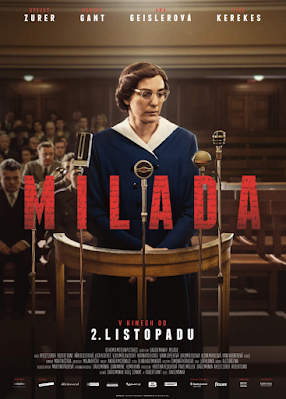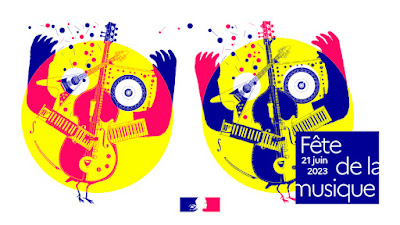Remember her.
 |
| Milada Horakova at her show trial in 1950. |
Milada Horakova was hanged with three others in Prague’s Pankrac Prison as a spy and traitor to the Communist Czechoslovakian government on June 27, 1950. She was a lawyer, social democrat, and a prominent feminist in the interwar and postwar periods.
Milada had been a member of the Czech resistance to the Nazi occupation of her homeland and survived a Nazi prison. After Czechoslovakia was liberated from the Nazis in 1945 by the Soviets she became a member of parliament in 1946 but resigned her seat after the Communist coup of 1948.
However she refused to abandon her country. She was arrested at her office on September 27, 1949 "on charges of conspiracy and espionage against the state."
Milada was subjected to a show trial.
Oxford Languages defines a show trial as "a judicial trial held in public with the intention of influencing or satisfying public opinion, rather than of ensuring justice."
Vladimir Lenin called them "model trials", but they would eventually become known as show trials under Josef Stalin with hundreds of thousands executed and millions sent to work camps in Siberia, and they would take place not only in the Soviet Union, but in the East Bloc including Czechoslovakia, and as far away as Cuba. The Nazis also copied the practice, and so have other repressive regimes.
Seventy three years after Milada Horakova addressed the court in the final day of her show trial on June 8, 1950 her words ring true and strong:
"I have declared to the State Police that I remain faithful to my convictions, and that the reason I remain faithful to them is because I adhere to the ideas, the opinions and the beliefs of those who are figures of authority to me. And among them are two people who remain the most important figures to me, two people who made an enormous impression on me throughout my life. Those people are Tomas Garrigue Masaryk and Eduard Benes. And I want to say something to those who were also inspired by those two men when forming their own convictions and their own ideas. I want to say this: no-one in this country should be made to die for their beliefs. And no-one should go to prison for them."
Her life story was brought to big screen in 2017and on January 12, 2018 was available on Netflix, and is now available on Amazon. Below is an English trailer for this important film.
Adam D. E. Watkins in his 2010 paper "The Show Trial of J U Dr. Milada Horáková: The Catalyst for Social Revolution in Communist Czechoslovakia, 1950" explains the importance of the show trial in gutting democratic traditions and replacing them with Stalinism:
The study deconstructs the show trial’s influence on inducing a country to foster the Communist movement against decades of democratic traditions. The research reveals the impact of the show trial of Dr. Milada Horáková in 1950 and how it was instrumental in reforming a society, marked the beginning of Stalinism, and ushered forth a perverted system of justice leading to a cultural transformation after the Communist putsch. Furthermore, the revolution truncated intellectual thought and signified the end of many social movements – including the women’s rights movementAccording to D. E. Watkings Horáková was seen by the public as a symbol of the First Republic and of democracy. Unlike others who did break under the relentless psychological and physical torture she never did. The communists tried to edit her testimony for propaganda purposes but as Radio Prague in their 2005 report on the discovery of the unedited tapes of her trial:
[S]he faced her show trial with calm and defiance, refusing to be broken. Audio recordings - intended to be used by the Communists for propaganda purposes - were mostly never aired, for the large part because for the Party's purposes, they were unusable.
Because she refused to cooperate with the Stalinists her punishment was particularly severe, even for the death penalty. In 2007 her prosecutor Ludmila Brozova-Polednova who in 1950 had helped to condemn Horakova to death, now 86, was tried as an accomplice to murder. During the trial Radio Prague reported that a note written by an anonymous eye-witness to Milada Horakova's execution quoted the young prosecutor recommending: "Don't break her neck on the noose, Suffocate the bitch - and the others too." Milada Horáková was executed in Pankrác Prison on 27 June 1950 by a particularly torturous method: "intentionally slow strangulation, which according to historians took 15 minutes. She was 48 years old." The urn with her ashes was never given to her family nor is it known what became of them.
In a letter to her 16 year old teenage daughter
Milada explained why she had refused to compromise with evil. Her
daughter received the letter 40 years later after the end of communist
rule:
The reason was not that I loved you little; I love you just as purely and fervently as other mothers love their children. But I understood that my task here in the world was to do you good … by seeing to it that life becomes better, and that all children can live well. … Don’t be frightened and sad because I am not coming back any more. Learn, my child, to look at life early as a serious matter. Life is hard, it does not pamper anybody, and for every time it strokes you it gives you ten blows. Become accustomed to that soon, but don’t let it defeat you. Decide to fight.Hours prior to her execution she reaffirmed her position to her family:
I go with my head held high. One also has to know how to lose. That is no disgrace. An enemy also does not lose honor if he is truthful and honorable. One falls in battle; what is life other than struggle? (Both quotes excerpts taken from here)
Ms. Brožová-Polednová, the prosecutor, was found guilty and sentenced to six years in prison in 2008 but was given a presidential pardon by Vaclav Klaus on humanitarian grounds one year and six months into her sentence and released in 2010. The former prosecutor defended her actions claiming that what she did was legal and that she was "following orders." She tried to appeal her conviction at the Strasbourg Court in 2011 and lost.
S Evou jsme u Pomníku obětem komunismu vyjádřili úctu všem obětem komunistické totality. Mezi nimi i Miladě Horákové a dalším zavražděným ve vykonstruovaném procesu přesně před 73 lety. Vážím si všech, kteří měli k totalitnímu režimu vždy jasný postoj a odvahu se mu postavit. pic.twitter.com/7X6K5Wiqrc
— Petr Pavel (@prezidentpavel) June 27, 2023
Today, June 27, the day of Milada Horakova's execution is now recognized in the Czech Republic as “Commemoration day for the victims of the Communist regime.”
 |
| Biopic of the life of Milada Horáková (2017) |



























